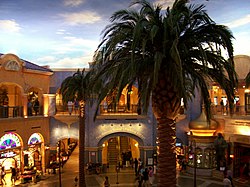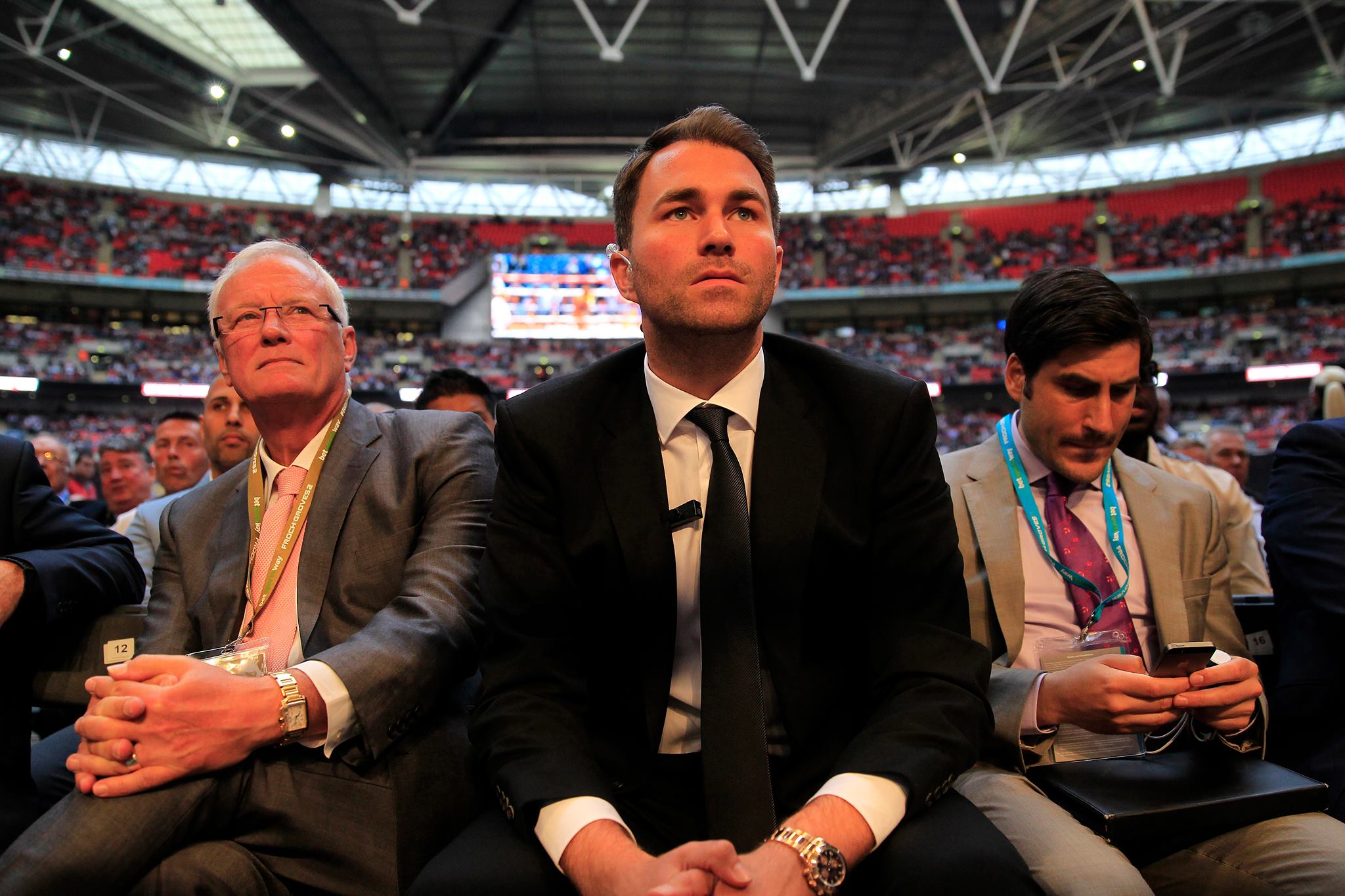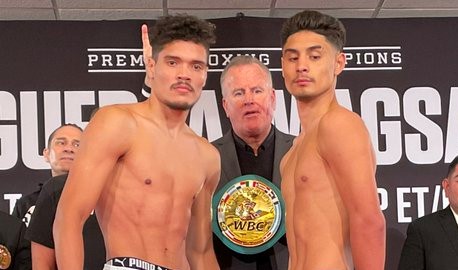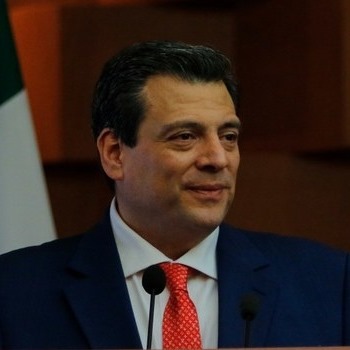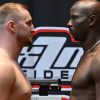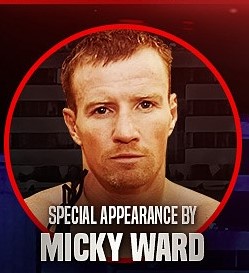Angelo Dundee: Mauro Mina Would Have Been A Champion in Any Era!
By: Ken Hissner
The film “Imagining Mina” is a bittersweet, yet inspiring story about the great 1960’s Peruvian boxer Mauro Mina. This multilayered film follows Mina’s unlikely journey – from the cotton fields of rural Peru to Madison Square Garden. Set in the context of mid-twentieth century Latin America, the film also analyses the world in which Mina lived and the obstacles he faced. He was Afro-Peruvian and faced racism prior boxing from 1955 to 1965 until his death in 1993 at the age of 59.

Within the movie it tells how Mina was dedicated himself to boxing. He would talk to whoever called on him, rich or poor. He created his own world. For a President of Peru the former General Ricardo Perez Godoy to intervene in the career of an athlete because he was Mauro Mina and the economic impact was obvious. He awarded Mina with a Gold watch.
Mina’s mother left when he was an infant. His father doted on him but passed away when Mina was 7. He lived with his grandparents and the step-grandmother Susana beat him almost daily. After his grandfather passed when Mina was 12 he moved back in with his mother. A local friend of his mother’s had him work in the slaughter house. He became very strong at a young age. He went to school at 11 and quit at 14 to work full time. He went to Lima to box on an amateur show and decided to stay with an aunt and never see his mother again.
How Mina got started boxing was when he would pass by a group of boy’s each day who set up a gym on the outside. It took three times of asking him before he tried boxing. By the time he was 15 he was known as a knockout artist. When he was 17 he was asked to move to Lima to continue his amateur career. He moved to there and lived with his aunt never seeing his mother again. At 20 he joined the military thinking his boxing career was going nowhere.
He experienced racism as a descendent of Africans, the manipulation of the media and the curious politics of the boxing business. “Imagining Mina” weaves candid, first-hand accounts, newly recorded digital images; and rare archival images; to recreate the captivating story of common man who became a national icon and international sensation. Alfredo Bejar directed and promoted this film. This writer purchased this DVD telling the story to get the full depth from start to finish.
As an amateur Mina won the Latin American Games middleweight title in 1952. He won his first 6 professional bouts and by nearing the 2 year mark boxing his promoter Max Aguirre who as a promoter received criticism and an equal amount of praise. Mina had only fought 10 rounds so when it was decided to see what he was made of his promoter took him to Sao Paulo, Brazil to fight Luis Ignacio, 22-2-1. Mina scored a first round knockdown but lost a close decision.
Mauro Mina, Jr., today said of his father “he’d say I’m going to bring the sun for the light. And the sun would come out, by coincidence. He won people over.” He was getting robbed by those managing him only giving him $50-100 while fighting 10 round bouts. He may not have been making much money but he was fighting often.
“Life told me something” he would say. He would settle with an old ally who offers to help named Oscar Teran who would become his manager. He knew things and knew Aguirre who said “I’ll manage you, not Max. When I tell you something you do it.” His brother Alejandro said “he was a beautiful person. He was like a father to Mauro and involved with the government industry where he had contacts and was well off. He began to manage Mina without pay. Will Mauro be a South American champion which meant a lot to the Peruvian people? He defeated Antonio Diaz, 49-10-17, twice. He had a rematch with Ignacio in July of 1958 which ended in a draw in Lima.
Mina was matched with the South American champion Dogomar Martinez, 46-2-5, in Montevideo, Uruguay. “I trained just like before otherwise I wouldn’t make such a long trip. The problem was Martinez was also well prepared. He got a new trainer in Otto Salas. Mina looked quicker, He used his right hand more. “Before I had to tie his left hand so he’d work only with his right,” said Salas. Mina starts out countering and by the fourth round Martinez becomes more aggressive. Martinez was awarded the fight 6-4-5. Martinez said “that’s a future champion.”
On Mina’s return to Lima the journalists started their criticism saying “he doesn’t have the making of a champion.” Shortly after fighting Martinez he was driving with a friend who had an accident leaving Mina with a scar on his right cheek. Joe de Leon from Panama was considered to become his trainer. “For a long time, 30 years, until he got the opportunity to train the star of Peru, Mauro Mina,” said Joe de Leon, Jr.
A foreign executive came to Lima to run the phone company for IT & T. He became Mina’s sponsor and gave him a job. He agreed to have de Leon train him but said Mina was getting a new trainer with each fight and needed to stick with just one. “I’ll train him only if he wants me to train him. First I’ll train him, he’ll fight and if my work is satisfactory we’ll talk about compensation,” said de Leon. He was a class act, a real gentleman.
With all the pieces in place Mina returned to the ring after 6 months to face one of Argentina’s top prospects named Rodolfo Diaz, 4-0-1, defeating him in back to back fights. Mina was knocked down in the first fight which would be the only time during his career he was knocked down. “Rodolfo Diaz by the way was one hell of a fighter. He was a sturdy guy with a great chin. He had a big heart and was determined to hang in there. He wasn’t discouraged easy and made good fights. For Mina to lick this guy twice was quite an achievement,” said Hank Kaplan, Boxing Historian.
“De Leon taught him how to fight inside, up close and how to bob and weave. He was no longer a stiff boxer. He knew how to dodge and connect inside”, said Dr. Pamarino. (Former sparring partner) “My father said Mauro was too nice. He was too nice of a guy. To inspire to be a champion he had to make him nastier and turn him into an aggressive guy without being mean. He simply took on the attributes of a champion,” said De Leon, Jr.
After winning 12 straight Mina defeated Argentina’s Gregorio Peralta, 11-2-3, stopping him in 8 rounds. He got up to 16 straight when he fought Humberto Loayza of Chile whom he had defeated 2 months prior to this with this time ending in a draw. Within 30 days Mina was proclaimed South American champion the end of 1960. The following month they had their third meeting with Mina scoring a fifth round knockout.
“Mina’s popularity grows. Newspapers fill page after page. He does television interviews and becomes a national figure. The masses followed him wherever he went because they didn’t just value his athletic achievements. They valued his qualities in and out of the ring. He was always mindful of how he acted. To him everyone was a friend. There were no enemies. He was down to earth. Rich and poor people could call and talk to him.
“Fighters Mina was fighting were like the who’s who of boxing. He was like the Ray Robinson of his hometown. Boxing is no different than any other profession. You’re selling a product and if you have a product like Mina you have no problem because he can handle himself in any situations”, said Dundee. Former world light heavyweight champion who lost to Mina early in his career had this to say about Mina,
After winning 21 straight plus the draw Mina defeated Jesse Bowdry, 28-8, from the US, who had fought Harold Johnson 6 months prior to this for the vacant NBA title. This win put Mina in the NBA ratings at number 10. Mina knocked out Jamaican Allan Harmon, 27-7-3. In the dressing room after the fight Harmon still doesn’t remember the end of the fight due to the right cross from Mina had so much effect on him. “Harmon was a tough young man who fought a draw with Henry Hank in Miami Beach,” said Dundee.
Mina knocked out the number six contender Von Clay, 16-6-2, when Mina was number seven contender. The fight was exciting because Clay hurt Mina with a right cross. But one of Mina’s virtues was his ability to recover. Clay must have thrown 50 punches with only a handful landing. Mina landed a 5 punch combination in the sixth round before Clay dropped to the canvas. The people were ecstatic and applauded him for half an hour after this win. He followed this fight against Cuban Lino Rendon, 16-10-1. Mina was hit with a hard right that he said “temporarily blinded me.” Mina went on to win.
Mina took a trip to Philadelphia in 1962 when NBA champion Harold Johnson was defending against Doug Jones. Mina was introduced in the ring challenging the winner. Johnson won and was offered 50k to come to Lima but turned it down. A month after defeating Jones, Johnson traveled to Germany and defeated the European champion Gustav “Bubi” Scholz, 85-1-6. Johnson once told me Scholz was as good as the American fighters.
This writer only saw Mina fight one time in his only fight in the US in November of 1962 defeating Detroit’s “Hammerin” Henry Hank, 53-16-3, by split decision. Referee Arthur Mercante had it 6-3 while another judge Bill Recht 5-3 both for Mina. Judge Artie Aidala 6-4 for Hank. This writer had it 6-4 for Mina while pulling out those last 2 rounds. Prior to the fight Announcer Don Dunphy called it a carnival like atmosphere with mostly Puerto Ricans supporting Mina.
The matchmaker of the Garden had told Mina’s advisor “he will be the challenger.” In Hank’s previous fight he defeated future heavyweight champion Jimmy Ellis. Hank took the first two rounds before Mina opened up in the third round but Hank came back in taking the fourth. In the fifth a fight broke out with Mina coming out aggressively on top. He also took the sixth and seventh rounds. Hank landed uppercuts in the eighth to take the round. He looked like he thought he was ahead going into the last round as Mina finished the stronger of the two.
The Hank fight was in between a pair of wins over Seattle’s Eddie Cotton, 42-12-1, in Peru. It was marred by a plane crash the day before when 97 people died with little to cheer about when Mina returned from New York.
Cotton was the number one contender but Mina replaced him at that position after defeating him. Cotton agreed to come to Lima Mina was placed face to face with his destiny. The first fight had 32,900 in attendance in October of 1962. The second one had 35,000 in attendance in January of 1963. Previously in August of 1961 Cotton had lost by split decision to NBA world champion Harold Johnson. The winner of the first Cotton-Mina fight was to get a shot at Johnson’s title in Madison Square Garden which was later changed to the Convention Center in Las Vegas, NV.
Cotton brought his trainer, meat and water for this second fight. The second fight was a lot rougher for Mina. His management wanted him to have 3 more fights before challenging for the title. He won them with the last one defeating future champion Bob Foster. “Angelo Dundee sent me down to fight Mina. They didn’t know how tall I was or the puncher I was,” said Foster. Mina suffered a cut over his left eye.
Early in 1963 Mina was to get his title shot but claimed he hurt his right hand with pain from the hand to the elbow that felt like small snakes cancelling his fight with Johnson. He was moved to a private room with a sign saying “Dangerous Crazy Man” to keep the press away. He also had Glaucoma in his left eye. The hospitals doctor denied the eye operation. Mina denied having a problem with his left eye. Johnson would lose his title to Willie Pastrano who filled in for Mina. The Cotton-Mina second fight winner was to get a title fight with Pastrano but when Pastrano lost a non-title fight to Peralta he was obligated to fight him in 1964 retaining the title.
Boxing manager Jim Jacobs told me it was the worst decision he ever saw of the thousands of films he owned saying Johnson won it. Mina went to a hospital after this fight and it was hush-hush what his injury’s from the fight amounted to. Rumors were he had a detached retina. New York physician discovered this on a Mina visit and took away his license as did Peru and the rest of the boxing world. Madison Square Garden’s President John Condon was told by Mina’s former promoter Aguirre about the operation. Aguirre denied the accusation. The physician felt it was a successful operation but despite that it cost the Garden 100k for this cancellation. Mina would have gotten 20k for the fight.
Mina returned to the ring after 8 months and defeated Roque Maravilla, 34-9-1, of the US when the fight fell through between Johnson and Mina. “I would have loved to of had a kid like Mauro Mina. He was the kind of guy people wanted to see. Mauro Mina would have been great at any time,” said Angelo Dundee. The boxer who defeated Pastrano for the championship Jose Torres said, “Mina was a very nice guy, well- mannered and a thinker.”
Historian Kaplan said “Eddie Cotton had great techniques, a classic boxer. He danced well. He used his arms with a mastery that neutralized his rivals. Cotton the painter and Mina the sculptor. Not only poor people went to see Mina fight but from all social classes and Mina represented a national continent and a country like ours that needs triumph in all areas, not just in sports.”
Taking a look back to the beginning of Mina’s career after winning his first 6 fights starting in October of 1955, Mina was ill advised to take on the much more experienced Brazilian champion Luis Ignacio, 22-2-1, losing in Sao Paulo, BRZ. In a rematch in 1958 it ended in a draw, in Peru. In his next fight being just 10-1-1 he traveled to Montevideo, URG, and lost to Dogomar Martinez, 46-2-5, who was the South American champion by a score of 6-4-5. Mina would go onto win 16 straight including Argentine’s Gregorio Peralta, 11-2-3. It included in his first of 3 fights with Humberto Loayza, 37-18-4, of Chile. In their second fight it ended in a draw while Mina won the South American title in their third and last fight scoring a knockout.
In November of 1963 Mina defeated future world champion Bob Foster, 11-1, over 10 rounds. “We hurt each other. When I hurt him they’d ring the bell. I had a few lumps. He was a good fighter and the best I had fought in the light heavyweight division. He would have beaten Pastrano,” said Bob Foster.
Mina would fight Thomas again in Lima ending in a draw though the fight was scheduled for New York originally. Mina’s left eye was shut tight. He would go on a 20 fight win streak before losing in a rematch to Gregorio Peralta, 42-4-4, who was then the South American heavyweight champion in September of 1964. Mina had stopped Peralta when both were light heavyweights in June of 1960. He was 37-0-2 over 39 fights. Mina said he was tired of boxing after this fight. Dr. Francisco Levano of the Boxing Federation advised him to stop fighting because there was no guarantee the eye would be injured again.
Mina’s son said he’d tell us “you discriminate against yourselves sometimes. I won’t go to place’s because they may discriminate against me. He taught us that we’re not different from others. We are all equal.” In 1964 Mina was 31 and his wife Sophia 18 when they married after knowing each other for a year. There were 1,000 people in attendance and another 5,000 outside the church. It caused a negative reaction due to his wife being white by the black women in Mina’s circle. When they left the church Mina had one of his gloves and a hankie from him. They tried to take Sophia’s veil. They would go onto have 3 children. This wedding was marred by a riot during a soccer game between Peru and Argentina that killed 253 people.
Mina ended his career defeating Italy’s champion Piero Del Papa, 28-1-3, before 15,000 in attendance in November of 1965. Del Papa would win the European title in his next fight. He turned professional at the age of 21 and in his last fight he was 31 just weeks before his 32nd birthday. He announced his retirement in April of 1966. He continued with his boxing academy and built several apartments for added income. He taught at a Naval School and trained Peru’s National team and became a successful manager. He passed away at the age of 59 of complications from a stroke in June of 1993. He was known as a “champion without a crown!”
“Mauro Mina would have been a champion in any era. I’m talking about a 60 year span because I’ve been around for 60 years,” said Angelo Dundee.


